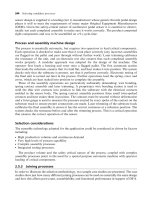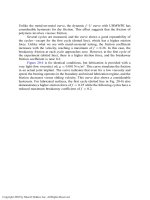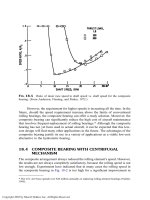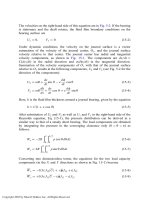Bearing Design in Machinery Episode 2 Part 4 doc
Bạn đang xem bản rút gọn của tài liệu. Xem và tải ngay bản đầy đủ của tài liệu tại đây (214.04 KB, 12 trang )
Similar to the hydrodynamic journal bearing, the load of the hydrostatic
journal bearing is also divided into two components, W
x
and W
y
, and the
displacement of the bearing center e is divided into two components, e
x
and e
y
.
In Chapter 7, the two components of the journal bearing stiffness are defined [Eq.
(7-31)], and the cross-stiffness components are defined in Eq. (7-32). Cross-
stiffness components can result in bearing instability, which was discussed in
Chapter 9.
10.12 APPLICATIONS
An interesting application is the hydrostatic pad in machine tool screw drives
(Rumberger and Wertwijn, 1968). For high-precision applications, it is important
to prevent direct metal contact, which results in stick-slip friction and limits the
machining precision. Figure 10-7 shows a noncontact design that includes
hydrostatic pads for complete separation of the sliding surfaces of screw drive.
Another important application is in a friction testing machine, which will be
described in Chapter 14.
10.13 HYDRAULIC PUMPS
An example of a positive-displacement pump that is widely used for lubrication is
the gear pump. The use of gear pumps is well known in the lubrication system of
automotive engines. Gear pumps, as well as piston pumps, are positive-displace-
ment pumps; i.e., the pumps deliver, under ideal conditions, a fixed quantity of
liquid per cycle, irrespective of the flow resistance (head losses in the system).
However, it is possible to convert the discharge at a constant flow rate to
discharge at a constant pressure by installing a pressure relief valve that maintains
a constant pressure and returns the surplus flow.
A cross section of a simple gear pump is shown in Fig. 10-8a. A gear pump
consists of two spur gears (or helix gears) meshed inside a pump casing, with one
of the gears driven by a constant-speed electric motor. The liquid at the suction
side is trapped between the gear teeth, forcing the liquid around the casing and
finally expelling it through the discharge. The quantity of liquid discharged per
revolution of the gear is known as displacement, theoretically equal to the sum of
the volumes of all the spaces between the gear teeth and the casing. However,
there are always tolerances and small clearance for a free fit between the gears and
casing. The presence of clearance in pump construction makes it practically
impossible to attain the theoretical displacement.
The advantages of the gear pump, in comparison to other pumps, are as
follows.
Copyright 2003 by Marcel Dekker, Inc. All Rights Reserved.
3. It can handle very high-viscosity fluid.
4. It can generate very high heads (or outlet pressure) in comparison to
centrifugal pumps.
5. It is self-priming (unlike the centrifugal pump). It acts like a compres-
sor and pumps out trapped air or vapors.
6. It has good efficiency at very high heads.
7. It has good efficiency over a wide speed range.
8. It requires relatively low suction heads.
The flow rate of a gear pump is approximately constant, irrespective of its
head losses. If we accidentally close the discharge valve, the discharge pressure
would rise until the weakest part of the system fails. To avoid this, a relief valve
should be installed in parallel to the discharge valve.
When a small amount of liquid escapes backward from the discharge side
to the suction side through the gear pump clearances, this is referred to as slip.
The capacity (flow rate) lost due to slip in the clearances increases dramatically
with the clearance, h
0
, between the housing and the gears (proportional to h
3
0
) and
is inversely proportional to the fluid viscosity. An idea about the amount of liquid
lost in slippage can be obtained via the equation for laminar flow between two
parallel plates having a thin clearance, h
0
, between them:
Q ¼
lh
3
0
12mb
Dp ð10-49Þ
where
Q ¼ flow rate of flow in the clearance ðslip flow rateÞ
Dp ¼ differential pressure ðbetween discharge and suctionÞ
b ¼ width of fluid path ðnormal to fluid pathÞ
h
0
¼ clearance between the two plates
m ¼ fluid viscosity
l ¼ length along the fluid path
This equation is helpful in understanding the parameters affecting the magnitude
of slip. It shows that slip is mostly dependent on clearance, since it is proportional
to the cube of clearance. Also, slip is proportional to the pressure differential Dp
and inversely proportional to the viscosity m of the liquid. Gear pumps are
suitable for fluids of higher viscosity, for minimizing slip, and are widely used for
lubrication, since lubricants have relatively high viscosity (in comparison to
water). Fluids with low viscosity, such as water and air, are not suitable for gear
pumps.
Piston pumps are also widely used as high-pressure positive-displacement
(constant-flow-rate) hydraulic pumps. An example of the multipiston pump is
Copyright 2003 by Marcel Dekker, Inc. All Rights Reserved.
shown in Fig. 10-8b. The advantage of the piston pump is that it is better sealed
and the slip is minimized. In turn, the efficiency of the piston pump is higher,
compared to that of a gear pump, but the piston pump requires valves, and it is
more expensive.
10.14 GEAR PUMP CHARACTERISTICS
The actual capacity (flow rate) and theoretical displacement versus pump head are
shown in Fig. 10-9. The constant theoretical displacement is a straight horizontal
line. The actual capacity (flow rate) reduces with the head because the ‘‘slip’’ is
proportional to the head of the pump (discharge head minus suction head). When
the head approaches zero, the capacity is equivalent to the theoretical displace-
ment.
10.14.1 Hydraulic Power and Pump E⁄ciency
The SI unit of power
_
EE is the watt. Another widely used unit is the Imperial unit,
horse power [HP]. Brake power,
_
EE
b
(BHP in horsepower units), is the mechanical
shaft power required to drive the pump by means of electric motor. In the pump,
this power is converted into two components: the useful hydraulic power,
_
EE
h
, and
the frictional losses,
_
EE
f
. The useful hydraulic power can be converted back to
work done by the fluid. A piston or hydraulic motor can do this energy
conversion. In the pump, the friction losses are dissipated as heat. Friction
FIG. 10-9 Gear pump Q–H characteristics.
Copyright 2003 by Marcel Dekker, Inc. All Rights Reserved.
losses result from friction in the bearings, the stuffing box (or mechanical seal),
and the viscous shear of the fluid in the clearances.
In Fig. 10-10, the curves of the various power components
_
EE versus pump
head H
p
are presented in horsepower [HP] units. The frictional horsepower [FHP]
does not vary appreciably with increased head; it is the horizontal line in Fig. 10-
10. The other useful component is the hydraulic horsepower [HHP]. This power
component is directly proportional to the pump head and is shown as a straight
line with a positive slope. This component is added to constant FHP, resulting in
the total brake horsepower [BHP].
The BHP curve in Fig. 10-10 is a straight line, and at zero pump head there
is still a definite brake horsepower required, due to friction in the pump. In a gear
pump, the friction horsepower, FHP, is a function of the speed and the viscosity of
the fluid, but not of the head of the pump. Because FHP is nearly constant versus
the head, it is a straight horizontal line in Fig. 10-10. On the other hand, HHP is
an increasing linear function of H
p
(see equation for hydraulic power). (This is
approximation, since Q is not constant because it is reduced by the slip.) The sum
of the friction power and the hydraulic power is the brake horsepower. The brake
horsepower increases nearly linearly versus H
p
, as shown in Fig. 10-10. Since
FHP is constant, the efficiency Z is an increasing function versus H
p
. The result is
that gear pumps have a higher efficiency at high heads.
FIG. 10-10 Power and efficiency characteristics of the gear pump.
Copyright 2003 by Marcel Dekker, Inc. All Rights Reserved.
The head of the pump, H
p
, generated by the pump is equal to the head
losses in a closed-loop piping system, such as in the hydrostatic bearing system.
If the fluid is transferred from one tank to another at higher elevation, the head of
the pump is equal to the head losses in the piping system plus the height
difference DZ.
The head of the pump, H
p
, is the difference of the heads between the two
points of discharge and suction:
H
p
¼ H
d
À H
s
ð10-50Þ
Pump head units are of length (m, ft). Head is calculated from the Bernoulli
equation. The expression for discharge and suction heads are:
H
d
¼
p
d
g
þ
V
2
d
2g
þ Z
d
ð10-51Þ
H
s
¼
p
s
g
þ
V
2
s
2g
þ Z
s
ð10-52Þ
where
H
d
¼ head at discharge side of pump ðoutletÞ
H
s
¼ head at suction side of pump ðinletÞ
p
d
¼ pressure measured at discharge side of pump ðoutletÞ
p
s
¼ pressure measured at suction side of pump ðinletÞ
g ¼ specific weight of fluid ðfor water; g ¼ 9:8 Â10
3
½N=m
3
Þ
V ¼ fluid velocity
g ¼ gravitational acceleration
Z ¼ height
The pump head, H
p
, is the difference between the discharge head and
suction head. In a closed loop, H
p
is equal to the head loss in the loop. The
expression for the pump head is
H
p
¼
p
d
À p
s
g
þ
V
2
d
À V
2
s
2g
þðZ
d
À Z
s
Þð10-53Þ
The velocity of the fluid in the discharge and suction can be determined
from the rate of flow and the inside diameter of the pipes. In most gear pumps, the
pipe inside the diameters on the discharge and suction sides are equal. In turn, the
discharge velocity is equal to that of the suction. Also, there is no significant
difference in height between the discharge and suction. In such cases, the last two
Copyright 2003 by Marcel Dekker, Inc. All Rights Reserved.
terms can be omitted, and the pump is determined by a simplified equation that
considers only the pressure difference:
H
p
¼
p
d
À p
s
g
ð10-54Þ
10.14.2 Hydraulic Power
The hydraulic power of a pump,
_
EE
h
, is proportional to the pump head, H
p
,
according to the following equation:
_
EE
h
¼ QgH
p
ð10-55Þ
The SI units for Eq. (10-53), (10-54), and (10-55) are
_
EE
h
½w
Q ½m
3
=s
g ½N=m
3
H ½m
p ½N=m
2
or pascals]
The pump efficiency is the ratio of hydraulic power to break power:
Z ¼
_
EE
h
_
EE
b
ð10-56Þ
The conversion to horsepower units is 1 HP ¼ 745.7 W. In most gear pumps, the
inlet and outlet pipes have the same diameter and the inlet and outlet velocities
are equal.
In Imperial units, the hydraulic horsepower (HHP) is given by
HHP ¼
QDp
1714
ð10-57Þ
Here, the units are as follows:
Dp ½psi¼gðH
p
À H
s
Þ and Q ½GPM
In imperial units, the efficiency of the pump is:
Z ¼
HHP
BHP
ð10-58Þ
The BHP can be measured by means of a motor dynamometer. If we are
interested in the efficiency of the complete system of motor and pump, the
input power is measured by the electrical power, consumed by the electric motor
Copyright 2003 by Marcel Dekker, Inc. All Rights Reserved.
that drives the pump (using a wattmeter). The horsepower lost on friction in the
pump, FHP, cannot be measured but can be determined from
FHP ¼ BHP ÀHHP ð10-59Þ
10.15 FLOW DIVIDERS
Using many hydraulic pumps for feeding the large number of recesses of
hydrostatic pads in machines is not practical. A simple solution of this problem
is to use constant pressure and flow restrictors. However, flow restrictors increase
the power losses in the system. Therefore, this method can be applied only with
small machines or machines that are operating for short periods, and the saving in
the initial cost of the machine is more important than the long-term power losses.
Another solution to this problem is to use flow dividers. Flow dividers are
also used for distributing small, constant flow rates of lubricant to rolling-element
bearings. It is designed to divide the constant flow rate of one hydraulic pump
into several constant flow rates. In hydrostatic pads, each recess is fed at a
constant flow rate from the flow divider. The advantage of using flow dividers is
that only one hydraulic pump is needed for many pads and a large number of
recesses.
The design concept of a flow divider is to use the hydraulic power of the
main pump to activate many small pistons that act as positive-displacement
pumps (constant-flow-rate pumps), and thus the flow of one hydraulic pump is
divided into many constant flow rates. A photo of a flow divider is shown in Fig.
10-11a. Figure 10-11b presents a cross section of a flow divider made up of many
rectangular blocks connected together for dividing the flow for feeding a large
number of bearings. The contact between the blocks is sealed by O-rings. The
intricate path of the inlet and outlet of one piston is shown in this drawing.
For a large number of bearings, the flow divider outlets are divided again.
An example of such a combination is shown in Fig. 10-12.
10.16 CASE STUDY: HYDROSTATIC SHOE
PADS IN LARGE ROTARY MILLS
Size reduction is an important part of the process of the enrichment of ores. Ball-
and-rod rotary mills are widely used for grinding ores before the enrichment
process in the mines. Additional applications include the reduction of raw-
material particle size in cement plants and pulverizing coal in power stations.
In rotary mills, friction and centrifugal forces lift the material and heavy
balls against the rotating cylindrical internal shell and liners of the mill, until they
fall down by gravity. The heavy balls fall on the material, and reduce the particle
size by impact. For this operation, the rotation speed of the mills must be slow,
Copyright 2003 by Marcel Dekker, Inc. All Rights Reserved.
For successful operation, rolling bearings as well as hydrodynamic bearings
require precision machining. For rolling-element bearings, any out-of-roundness
of the trunnion or the bearing housing would deform the inner or outer rings of
the rolling bearing. This undesired deformation would adversely affect the
performance of the bearing and significantly reduce its life. Moreover, large-
diameter rolling-element bearings are expensive in comparison to other alter-
natives. For a hydrodynamic bearing, the bearing and journal must be accurately
round and fitted together for sustained performance of a full hydrodynamic fluid
film. Any out-of-roundness in the bearing or journal results in a direct contact and
excessive wear. In addition, rotary mills rotate at relatively low speed, which is
insufficient for building up a fluid film of sufficient thickness to support the large
trunnion.
An alternative that is often selected is the hydrostatic bearing system. As
mentioned earlier, hydrostatic bearings can operate with a thicker fluid film and
therefore are less sensitive to manufacturing errors and elastic deformation.
10.16.1 Self- Aligning and Self-Adjusted
Hydrostatic Shoe Pads
A working solution to the aforementioned problems of large bearings in rotary
mills has been in practice for many years, patented by Arsenius, from SKF (see
Arsenius and Goran, 1973) and Trygg and McIntyre (1982). It is in the form of
self-aligning hydrostatic shoe pads that support the trunnion as shown in Fig. 10-
13. These shoe pads can pivot to compensate for aligning errors, in all directions.
Hydrostatic pads that pivot on a sphere for universal self-aligning are also used in
small bearings.
When two hydrostatic shoe pads support a circular trunnion (Fig. 10-13a),
the load is distributed evenly between these two pads. In fact, the location of the
two pads determines the location of the trunnion center. However, whenever three
or more pads are supporting the trunnion, the load is no longer distributed evenly,
and the design must include radial adjustment of the pads, as shown in Fig. 10-
13b.
The load capacity is inversely proportional to h
3
0
, where h
0
is the radial
clearance between the face of the hydrostatic pad and the trunnion running
surface. Due to limitations in precision in the mounting of the pads, the clearance
h
0
is never equal in all the pads. Therefore, the design must include adjustment of
the pad height to ensure that the load is distributed evenly among all the pads.
Adjustment is required only for the extra pads above the first two pads, which do
not need adjustment. Therefore, each of the extra hydrostatic pads must be
designed to move automatically in the radial direction of the trunnion until the
load is divided evenly among all pads. This way, the pads always keep a constant
clearance from the trunnion surface.
Copyright 2003 by Marcel Dekker, Inc. All Rights Reserved.
Since the pads are self-aligning and self-adjusting, the foundation’s
construction does not have to be precise, and a relatively low-cost welded
structure can be used as a bed to support the set of hydrostatic pads.
The design concept is as follows: The surface of the pads is designed with
the same radius of curvature as the trunnion outside surface. The clearance is
adjusted, by pad radial displacement, which requires additional lower piston and
hydraulic oil pressure for radial displacement. Explanation of the control of the
pad radial motion will follow shortly.
If sufficient constant-flow-rate of oil is fed into each pad from external
pumps, it is then possible to build up appropriate pressure in each of the pad
FIG. 10-13 Hydrostatic shoe pads: (c) Self-aligning ball support with pressure relief.
(d) Master and slave shoe pads. (From Trygg and McIntyre (1982), reprinted with
permission from CIM Bulletin.)
Copyright 2003 by Marcel Dekker, Inc. All Rights Reserved.
recesses for separating completely the mating surfaces by means of a thin oil film.
A major advantage of hydrostatic pads is that the fluid film thickness is
independent of the trunnion speed. The fluid film is formed when the trunnion
is stationary or rotating, and the mating surfaces are completely separated by oil
film during start-up as well as during steady operation.
All pads have universal angular self-aligning (see Fig. 10-13b). This is
achieved by supporting each pad on a sphere (hard metal ball), as shown in Fig.
10-13c, where the pad has a spheroid recess with its center coinciding with the
sphere center. In this way, it can tilt in all directions, and errors in alignment with
the trunnion outside surface are compensated.
However, the spheroid pivot arrangement under high load has a relatively
high friction torque. This friction torque, combined with the inertia of the pad,
would result in slow movement and slow reaction to misalignment. In fact, in
large hydrostatic pads the reaction is too slow to adequately compensate the
variable misalignment during the rotation of the trunnion.
To improve the self-alignment performance, part of the load on the metal
ball is relieved by hydrostatic pressure. The bottom part of the pad has been
designed as a piston and is pressurized by oil pressure. The oil pressure relieves a
portion of the load on the metal ball, and in turn the undesired friction torque is
significantly reduced, as shown schematically in Fig. 10-13c.
In Fig. 10-13b, the radial positions of two inner pads determine the location
of the axis of rotation of the trunnion; therefore, these two pads do not require
radial adjustments, and they are referred to as master shoe pads. Any additional
shoe pads require radial adjustment and are referred to as slave shoes. The design
of the master and slave shoe pads with the hydraulic connections is shown in Fig.
10-13d.
In the slave shoe, there is radial adjustment of the pad clearance with the
trunnion surface. The radial adjustment requires an additional lower piston, as
shown in Fig. 10-13d. The radial motion of the lower piston is by means of
hydrostatic oil pressure. The oil is connected by an additional duct to the space
beneath the lower pad. There is a hydraulic duct connection, and the pressures are
equalized in the two spaces below the two pads and in the pad recess (in contact
with the trunnion surface) of the master and slave shoes. Since there is a constant
flow rate, this equal pressure is a load-dependent pressure. If the area of the lower
piston is larger than the effective pad area, the lower piston will push the piston
and shoe pad in the radial direction (in the slave shoe) and adjust the radial
clearance with the trunnion until equal load capacity is reached in all pads.
The recess pressure is a function of the load and the pad effective area. As
the load increases, the film thickness diminishes and the pressure rises. It is
desirable to limit the pressure and the size of the pad. This can be achieved by
increasing the number of pads.
Copyright 2003 by Marcel Dekker, Inc. All Rights Reserved.
When the oil pump is turned off, the pads with the pistons return to the
initial position, where the pistons rest completely on the metal ball. The pistons of
the slave shoes must have sufficient freedom of movement in the radial direction
of the trunnion; therefore, only the master shoes carry the load when the
hydraulic system is not under pressure. To minimize this load, the master
shoes are placed in center positions between the slave shoes when four or six
shoes are used.
The combination of a master shoe and slave shoe operates as follows: The
effective areas of the two pads are equal. If the clearance is the same in both
shoes, the hydrostatic recess pressures must also be equal in the two pads. In this
case, the load on both shoe pads is equalized.
There is hydraulic connection between the lower piston cylinders of the
master and slave recesses (both are supplied by one pump). In this way, the load-
dependent pressure in the piston cylinder of the slave shoe will be the same as that
in the master shoe, resulting in equal load capacity of each shoe pad at all times.
This design can operate with certain deviation from roundness of the
trunnion. For example, if there is a depression (reduced radius) in the trunnion
surface, when this depression passes the pads of the slave shoe, the pressure at the
recess of this pad drops. At the same time, the master shoe pad has not yet been
affected by the depression and the pad of the master shoe will carry most of the
load for a short duration. After this disturbance, the pressure at the slave pad
would rise and lift the piston until there are equal recess pressures and load
capacity in the two pads. Similarly, if there is a bulge (increased radius) on the
surface of the trunnion, the process is reversed. In this way, the radial loads on the
master and slave shoes are automatically controlled to be equal (with a minimal
delay time). In conclusion, the clearances between the pads and trunnion surface
are automatically controlled to be equal even if the trunnion is not perfectly
round.
Cross-sectional views of the slave and master shoes and an isometric view
of the slave shoe are shown in Fig. 10-14. In the master pad, there is one oil inlet
and there is a hydraulic connection to the slave shoe. The pad recess of the slave
and master shoes is of a unique design. For stable operation, it is important that
the pad angular misalignment be immediately corrected. Each pad has one large
circular recess and four additional recesses at each corner, all hydraulically
connected. The purpose of this design is to have higher hydrostatic restoring
torque for fast correction of any misalignment error. Oil is supplied at equal
pressure to all the recesses (see Fig. 10-15).
For the large hydrostatic pads in rotary mills, each recess is fed at a constant
flowrate, and flow restrictors are not used. Large hydrostatic pads consume a lot
of power for the circulation of oil, and flow restrictors considerably increase
power losses. The preferred design is to use one central pump with flow dividers.
A standby pump in parallel is usually provided, to prevent loss of production in
Copyright 2003 by Marcel Dekker, Inc. All Rights Reserved.
drops, the mill rotation is stopped. Temperature monitoring is included to protect
against overheating of the oil.
10.16.2 Advantages of Self-Aligning Hydrostatic
Shoe Pads
Several publications related to the manufacture of these self-adjusting hydrostatic
pads claim that there are major advantages in this design: It made it possible to
significantly reduce the cost and to reduce the weight of the bearing and trunnion
as well as the length of the complete mill in comparison to hydrodynamic
bearings. Most important, it improved the bearing performance, namely, it
reduced significantly the probability of bearing failure or excessive wear.
The concept of this design is to apply self-aligning hydrostatic shoes,
preferably four shoes for each bearing. One important advantage of the design is
that the length of the trunnion is much shorter in comparison to that in
hydrodynamic bearing design. The shortening of the trunnion results in several
advantages.
1. It reduces the weight of the trunnion and thus reduces the total weight
of the mill.
2. It simplifies the feed into and from the mill.
3. It reduces the total length of the mill and its weight, resulting in
reduced bending moment, and thus the mill can be designed to be
lighter. It will, in fact, reduce the cost of the materials and labor for
construction of the mill.
4. It reduces the elastic deformation, in the radial direction, of the
trunnion.
5. Stiffer trunnion has significant advantages in bearing operation,
because it reduces roundness errors; namely, it reduces elastic defor-
mation to an elliptical shape.
In addition to shorter trunnion length, this design eliminates expensive castings
followed by expensive precise machining, which are involved in the manufactur-
ing process of the conventional hydrodynamic design. In this case, the casting can
be replaced by a relatively low-cost welded construction. The hydrostatic shoes
are relatively small, and their machining cost is much lower in comparison to that
of large bearings. Moreover, the hydrostatic design operates with a thicker oil film
and provides self-aligning bearings in all directions. These improvements prevent
unexpected failures due to excessive wear or seizure. This aspect is important
because of the high cost involved in rotary mill repair as well as loss of
production.
Copyright 2003 by Marcel Dekker, Inc. All Rights Reserved.









